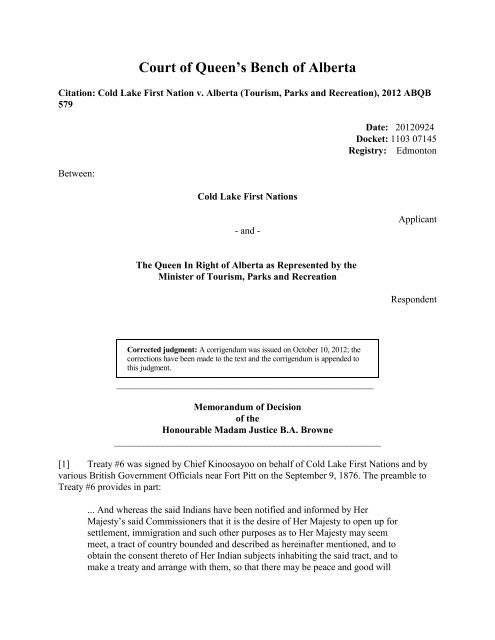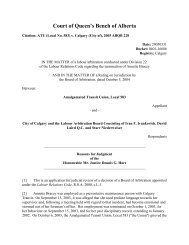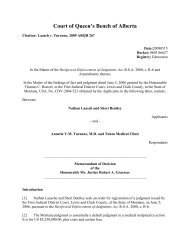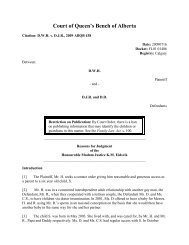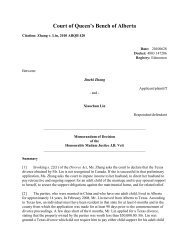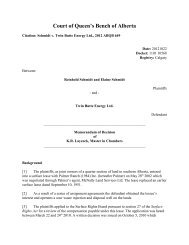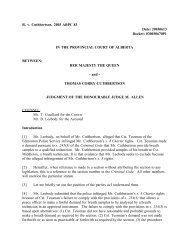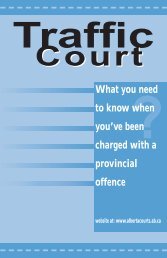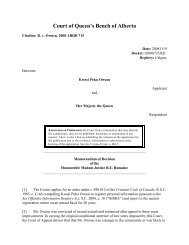Court of Queen's Bench of Alberta - Alberta Courts
Court of Queen's Bench of Alberta - Alberta Courts
Court of Queen's Bench of Alberta - Alberta Courts
Create successful ePaper yourself
Turn your PDF publications into a flip-book with our unique Google optimized e-Paper software.
<strong>Court</strong> <strong>of</strong> Queen’s <strong>Bench</strong> <strong>of</strong> <strong>Alberta</strong>Citation: Cold Lake First Nation v. <strong>Alberta</strong> (Tourism, Parks and Recreation), 2012 ABQB579Between:Cold Lake First NationsDate: 20120924Docket: 1103 07145Registry: Edmonton- and -ApplicantThe Queen In Right <strong>of</strong> <strong>Alberta</strong> as Represented by theMinister <strong>of</strong> Tourism, Parks and RecreationRespondentCorrected judgment: A corrigendum was issued on October 10, 2012; thecorrections have been made to the text and the corrigendum is appended tothis judgment._____________________________________________________Memorandum <strong>of</strong> Decision<strong>of</strong> theHonourable Madam Justice B.A. Browne_______________________________________________________[1] Treaty #6 was signed by Chief Kinoosayoo on behalf <strong>of</strong> Cold Lake First Nations and byvarious British Government Officials near Fort Pitt on the September 9, 1876. The preamble toTreaty #6 provides in part:... And whereas the said Indians have been notified and informed by HerMajesty’s said Commissioners that it is the desire <strong>of</strong> Her Majesty to open up forsettlement, immigration and such other purposes as to Her Majesty may seemmeet, a tract <strong>of</strong> country bounded and described as hereinafter mentioned, and toobtain the consent thereto <strong>of</strong> Her Indian subjects inhabiting the said tract, and tomake a treaty and arrange with them, so that there may be peace and good will
Page: 2between them and Her Majesty, and that they may know and be assured <strong>of</strong> whatallowance they are to count upon and received from Her Majesty’s bounty andbenevolence...[2] There is much jurisprudence regarding the interpretation and application <strong>of</strong> the contractsmade between Canadians and First Nations in 1876. This is one <strong>of</strong> those difficult cases where the<strong>Court</strong> is required to apply the guidelines provided in that Treaty/contract to modern day issueswhich could not have been contemplated by the signatories to the Treaty.[3] Cold Lake First Nations (“First Nation”) has brought an application for Judicial Reviewfrom a November 2010 decision <strong>of</strong> the North-East Regional Director <strong>of</strong> Parks, Government <strong>of</strong><strong>Alberta</strong> (“Parks”). The decision terminated ongoing consultations between the First Nation andParks and authorized a major expansion <strong>of</strong> the English Bay Recreation Area (“English Bay”) inthe traditional territory <strong>of</strong> the First Nation.[4] English Bay is located on the west shore <strong>of</strong> Cold Lake and is described as one <strong>of</strong> the mostbeautiful beaches in <strong>Alberta</strong>. Two parcels <strong>of</strong> the First Nation’s reserve lands are located northand south <strong>of</strong> the recreation area. Archaeological findings indicate that the area has been inhabitedfor 4,500 years. Non-aboriginal people have been resident in that area for only a recent andrelatively insignificant portion <strong>of</strong> that time period.[5] The First Nation calls this area Berry Point, Blueberry Point or in the Dene language, JiéHochálá. The area has been used over the years for transportation, hunting (ducks and animals),fishing, trapping, snaring, seasonal camps, preparing (drying), caching, smoking (meat and fish),picking and preserving berries (blueberries, saskatoon berries, raspberries, cranberries, gooseberries), and harvesting (birch bark and roots for medicines). Historical grave sites are locatedwithin the proposed extension to English Bay. It is conceded by all parties that the proposedexpansion would involve the First Nation’s Traditional Territory (not Reserve land).[6] The First Nation and other residents <strong>of</strong> the area became concerned about people campingon, and not taking care <strong>of</strong>, the land surrounding the existing Park. The expansion <strong>of</strong> English Baywas proposed because assigning Parks or Recreation status to an area assists the Provincialauthorities in monitoring the use <strong>of</strong> the land.[7] The parties to the Treaty and to the negotiation agree that Parks has a duty to consult theFirst Nation in the development <strong>of</strong> the extended campground through the First Nation’sTraditional Territory.[8] This judicial review requires me to address the following issues:1. Is the February 7, 2012 affidavit <strong>of</strong> Annette McCullough admissible forthe purposes <strong>of</strong> the judicial review?
Page: 32. Did Parks properly exercise its Constitutional duty to consult andaccommodate the First Nation?1. Is the February 7, 2012 affidavit <strong>of</strong> Annette McCullough admissible for the purposes<strong>of</strong> the judicial review?[9] The affidavit <strong>of</strong> Annette McCullough was sworn on February 7, 2012, and examinationson affidavit were subsequently conducted. The First Nation has submitted the affidavit, alongwith the enclosed Traditional Land Use and Occupancy Study (“TLUO Study”), to the <strong>Court</strong> forconsideration as evidence on this judicial review.[10] The purpose <strong>of</strong> a TLUO Study is to gather and prepare a survey or summary <strong>of</strong>information based upon the collective wisdom and information <strong>of</strong> the Study participants. It is acompilation <strong>of</strong> information gained from documents, articles, interviews and field visits. Theauthor <strong>of</strong> the Study then attempts to confirm the information and compile it in a useful format. Asummary <strong>of</strong> the findings <strong>of</strong> Annette McCullough’s TLUO Study provides in part (p. 3):6. To summarize the TLUO Study:Historic and Current Traditional Uses(a)Interviews <strong>of</strong> CLFN elders and other members indicate that Berry Pointhas been utilized by CLFN within living memory and since timeimmemorial for the following purposes:(i)(ii)(iii)(iv)(v)(vi)(vii)(viii)Seasonal settlement and social gathering...Fishing and processing fish...Gathering food plants and berries...Hunting and trapping...Gathering medicinal plants and other resources for healing andspiritual practice...Gathering birch bark and sap...Spiritual activities and connection to ancestors whose remains areburied throughout the area... andTravel corridors/ trails...(b)A map summarizing all <strong>of</strong> these uses as located by reports is found atFigure 5.16.[11] The Report also records concerns raised by the participants about the effect <strong>of</strong> theexpansion <strong>of</strong> the Recreation Area on the First Nation’s traditional lifestyle (p. 3, para. 6).(d)Elders and harvesters report that the proposed construction is likely to
Page: 4have serious negative impacts upon their community and their ability toutilize Berry Point for traditional purposes. The Study participants predictthese impacts and effects based upon their previous experiences withintheir traditional territory generally and within Berry Point moreparticularly. A summary <strong>of</strong> the expected impacts detailed in Section 6 <strong>of</strong>the TLUO Study is as follows:(i)(ii)(iii)(iv)(v)A loss <strong>of</strong> culture and language resulting from near total loss<strong>of</strong> one <strong>of</strong> the last remaining CLFN ancestral “living on theland places”;Chilling effect <strong>of</strong> increasing regulations, monitoring, andaccess fees which conflict with the Denesuline culturallypreferred means <strong>of</strong> using the land and harvesting resources;Physical changes to the landscape which destroy orirreparably alter berry patches, medicine gathering locationsand important animal and fish habitat;Physical changes to the landscape which destroy orirreparably alter traditional camping and social/ spiritualgathering locations;Increased use by non-CLFN members for recreationalpursuits (e.g. camping, powerboating, partying, etc.) which:(1) is incompatible with traditional uses (e.g. spiritual/healing retreat, berry/ medicine picking, net fishing,teaching children traditional ways etc.);(2) creates increased concern or risk <strong>of</strong> conflict withCLFN members and increased risk <strong>of</strong> vandalism toCLFN traditional use infrastructure (e.g. nets, boatsand smokehouses);(3) results in increased pollution <strong>of</strong> the area both in theobjective sense (e.g. more vehicle emissions andgarbage) and in the subjective sense (e.g.“disrespectful” use <strong>of</strong> the land decreases the quality<strong>of</strong> foods and medicines harvested in the area); and(4) interferes with solitude, peace and the “spirit <strong>of</strong> theland”.
Page: 5The First Nation’ Argument on the Admissibility <strong>of</strong> the TLUO Study[12] In seeking leave to admit the affidavit evidence, the First Nation relies on Rule 3.22(d) <strong>of</strong>the <strong>Alberta</strong> Rules <strong>of</strong> <strong>Court</strong>, arguing that the <strong>Court</strong> should exercise its discretion and admit theTLUO Study as it is logically probative <strong>of</strong> the facts in issue. The TLUO Study is important toprovide a complete context for the decision in issue, fills a gap, and assists with assessing thescope and strength <strong>of</strong> Treaty Rights as well as the magnitude <strong>of</strong> the adverse impact <strong>of</strong> thisproposed development. These in turn inform the content <strong>of</strong> the duty to consult. Once admitted,the <strong>Court</strong> can then determine the weight to be attributed to the evidence.[13] Further, the First Nation argues that the record is not the product <strong>of</strong> a quasi-judicialhearing. Parks is the decision maker and the opposing party on this judicial review, and it createdand controls the record. The honour <strong>of</strong> the Crown requires that the TLUO Study be filed tobalance the information contained in the record produced by Parks.[14] The First Nation also argues that the report should be admitted as expert evidence. Itargues that the Crown’s duty to consult is an emerging area <strong>of</strong> law, and therefore novel types <strong>of</strong>evidence should be admitted to allow proper consideration <strong>of</strong> the collective and communityviews which inform the <strong>Court</strong> when dealing with Aboriginal issues. The TLUO Study is relevantand not prejudicial. It provides the <strong>Court</strong> as trier <strong>of</strong> fact with information likely to be outside <strong>of</strong>its experience and knowledge. Annette McCullough is a properly qualified expert and has specialor peculiar knowledge <strong>of</strong> the matters to which she testifies; and the honour <strong>of</strong> the Crown weighsin favour <strong>of</strong> admission <strong>of</strong> the evidence. The First Nation argues further that the Study is arepresentation <strong>of</strong> its collective experience, it is a representational sample, and it was conducted inan impartial and independent manner.Parks’ Argument on the Admissibility <strong>of</strong> the TLUO Study[15] While acknowledging that oral history is generally admissible if it is useful andreasonably reliable, Parks submits that the flexibility required for resolution <strong>of</strong> Aboriginal claimscan be achieved through the ordinary procedural rules, and post-decision evidence is notgenerally admissible on a judicial review save in exceptional circumstances.[16] Parks argues that although the information in the format presented in the affidavit was notavailable to the decision maker, it was contained within the archaeological studies.[17] Further, Parks asserts that Ms. McCullough was retained in September 2011, she did notconduct the interviews, attend the site, or attend the community meetings. She oversaw thecompiling <strong>of</strong> the report. Aside from the documentation, the report is a compilation <strong>of</strong> hearsaywhich has not been tested on cross-examination. The qualifications <strong>of</strong> those who recorded thesubstance <strong>of</strong> the report are not before the <strong>Court</strong>. Concerns are raised about the selection <strong>of</strong>community members who participated in the Study and their “expertise” as elders, reporters or
Page: 6politicians.[18] Parks further argues that Ms. McCullough is put forward as an expert with a considerableamount <strong>of</strong> experience in terms <strong>of</strong> TLUO studies relating to proposed development projects. Inother words, her expertise is in gathering information and presenting it rather than forming anopinion based on supporting facts. The report is written from the First Nation’s perspective. It isnot in any way presented as an independent study but is rather a presentation on behalf <strong>of</strong> theFirst Nation. In fact, the interview guide for the TLUO Study indicates the following:...The information is needed to support CLFN’s court [case] against <strong>Alberta</strong> aboutredevelopment plans for the English Bay Provincial Recreation Area...[19] The consent form signed by interviewees similarly indicates that the purpose <strong>of</strong> theproject is to document the First Nation’s land use to support its court case “against English Bay”.[20] Parks argues that this is not a proper expert report. It is issued by a corporation. It is basedon double hearsay being reported by Ms. McCullough who received information through a staffmember who did interview various members <strong>of</strong> the First Nation. The report does not containscientific facts but rather is a gathering <strong>of</strong> stories, vignettes and opinions. It is a non-independent,partisan report prepared for one <strong>of</strong> the parties to the litigation. The reporters were paid anhonorarium and their evidence is not under oath.[21] Finally, Parks argues that the TLUO Study is not relevant to the determination on thisjudicial review. The case relates to proven treaty rights which are already recognized by <strong>Alberta</strong>and which formed the basis for the discussions and negotiations.Decision on the Admissibility <strong>of</strong> the TLUO Study[22] Rule 3.22(d) <strong>of</strong> the <strong>Alberta</strong> Rules <strong>of</strong> <strong>Court</strong> provides:3.22 When making a decision about an originating application for judicialreview, the <strong>Court</strong> may consider the following evidence only:(a)(b)(c)(d)the certified copy <strong>of</strong> the record <strong>of</strong> proceedings <strong>of</strong> the personor body that is the subject <strong>of</strong> the application, if any;if questioning was permitted under rule 3.21, a transcript <strong>of</strong>that questioning;anything permitted by any other rule or by an enactment;any other evidence permitted by the <strong>Court</strong>.
Page: 7[23] Slatter J. (as he then was) in <strong>Alberta</strong> Liquor Store Assn v <strong>Alberta</strong> (Gaming and LiquorCommission), 2006 ABQB 904, 406 AR 104 discussed at paras 40 to 43 the law concerningwhat evidence is relevant and admissible on a judicial review. Noting that judicial review isusually conducted based on the return, he listed circumstances where supplementary evidence isallowed: 1) to show bias, or a reasonable apprehension <strong>of</strong> bias; 2) where the facts in support <strong>of</strong>the allegation do not appear on the record; 3) where breach <strong>of</strong> the rules <strong>of</strong> natural justice will notbe apparent from the record; 4) exceptionally on other issues such as standing; and 5) where atribunal makes no, or an inadequate record <strong>of</strong> its proceedings, in order to show what evidencewas actually placed before the tribunal.[24] Slatter J. cited with approval S Blake, Administrative Law in Canada, 4th ed (Markham,Ont: LexisNexis Butterworths, 2006) at 198:Only material that was considered by the tribunal in coming to its decision isrelevant on judicial review. It is not the role <strong>of</strong> the court to decide the matteranew. The court simply conducts a review <strong>of</strong> the tribunal decision. For thisreason, the only evidence that is admissible before the court is the record that wasbefore the tribunal. Evidence that was not before the tribunal is not admissiblewithout leave <strong>of</strong> the court. If the issue to be decided on the application involves aquestion <strong>of</strong> law, or concerns the tribunal's statutory authority, the court will refuseleave to file additional evidence. Evidence challenging the wisdom <strong>of</strong> the decisionis not admissible. The tribunal's findings <strong>of</strong> fact may not be challenged withevidence that was not put before the tribunal. Fresh evidence, discovered since thetribunal made its decision, is not admissible on judicial review.[25] Judicial review is the review <strong>of</strong> a decision, not a hearing or decision de novo. Whenreviewing the reasonableness or the correctness <strong>of</strong> a decision, the reviewing court must undertakethat review based on the information available to the original decision maker. The issue in thisproceeding is not whether the First Nation’s views on the proposed development are preferable tothose <strong>of</strong> Parks. Rather, the main issue before this <strong>Court</strong> at this time is whether Parks failed toproperly exercise its Constitutional duty to consult and accommodate the First Nation whendiscussion and negotiation were concluded.[26] The First Nation cites Tsuu T’ina Nation v <strong>Alberta</strong> (Environment), 2008 ABQB 547,453 AR 114:28 The decision in Haida must be seen as a tacit approval <strong>of</strong> evidence, whichwould go beyond that contained in a return, being considered by the <strong>Court</strong> in ajudicial review when the Crown's duty to consult is an issue.29 Perhaps more fundamentally, the duty to consult is grounded in the honour<strong>of</strong> the Crown. It would not be in keeping with the honour <strong>of</strong> the Crown to strikeevidence which is available and might assist the <strong>Court</strong> in making a preliminary
Page: 8assessment <strong>of</strong> the merits <strong>of</strong> the right claimed and the other issues before the <strong>Court</strong>.[27] In my view, in judicial reviews in Aboriginal matters where the termination <strong>of</strong>consultation is in issue, courts should be careful to ensure that useful contextual information isnot excluded out <strong>of</strong> hand. Such evidence may be important, for example, to the determination asto whether the termination <strong>of</strong> consultation was premature given the information before thedecision maker.[28] It is clear from a review <strong>of</strong> the record that the Historical Resources Impact MitigationReport (“HRIM Report”) addresses many <strong>of</strong> the issues raised by the TLUO Study. Themethodology <strong>of</strong> the HRIM Report is similar to the TLUO Study in that it involved consultationwith the First Nation Elders and members, and also employed a number <strong>of</strong> the First Nationmembers on the excavation. The HRIM Report connects stories with artifacts and historicalevents and locations.[29] It is imperative as this area <strong>of</strong> the law develops that reasonable processes are available togather collective information and to present stories, vignettes <strong>of</strong> elders and others in thecommunity as the oral history passes down from generation to generation. That requiressensitivity, understanding and respect for that process on both sides. The very nature <strong>of</strong> oralhistory is that hearsay is involved in the gathering <strong>of</strong> that information. Through oral histories weare constantly looking for the common thread that connects and confirms the stories and historyrelated.[30] Ms. McCullough has skills and ability in gathering information from First Nationcommunities, and there are many potential uses for this TLUO Study. For example, it would havebeen useful in the ongoing negotiations which took place at various meetings where the FirstNation was attempting to establish to Parks’ satisfaction various traditional uses <strong>of</strong> the proposedexpansion <strong>of</strong> the campground. The cross-examination on Ms. McCullough’s transcript is notuseful in terms <strong>of</strong> advancing the First Nation’s position. It would have been much preferable tohave evidence or affidavits sworn by Band members so that the stories, vignettes and opinionscould be properly vetted through cross-examination on their affidavits.[31] The HRIM Report contains references to interviews with elders and complements thoseinterviews with objective findings through the archaeological work done. Interestingly, Ms.McCullough does not review the HRIM Report nor use it to confirm or to refute any <strong>of</strong> theconclusions or historical activities referred to in the TLUO Study.[32] In my view, the fact that some <strong>of</strong> the interviewees were paid an honorarium would notnecessarily affect the reliability <strong>of</strong> the report, unless the compensation is effected in such a wayas to encourage expression <strong>of</strong> a certain viewpoint or is otherwise shown to have underminedreliability.[33] As indicated, the TLUO Study may be useful in some circumstances. However, I find that
Page: 9it is not admissible on this application as post-decision material. The TLUO Study is acompilation <strong>of</strong> information already available through the HRIM Report, through the minutes andthrough the discussions <strong>of</strong> the parties. It adds little in the way <strong>of</strong> context. Its admission intoevidence would turn the judicial review into a hearing de novo. Its admission would not assist the<strong>Court</strong> in determining whether Parks failed to properly exercise its Constitutional duty to consultand accommodate the First Nation by ceasing discussions and negotiations.[34] For the above reasons, the First Nation’s application to admit the TLUO Study intoevidence on this judicial review is dismissed.[35] Parks requested a ruling that there is no implied undertaking not to disclose supportingdocuments to the TLUO Study. Since that Study is not admissible in these proceedings, it is notnecessary to discuss whether there is an implied undertaking regarding the use <strong>of</strong> the materialgathered.2. Did Parks properly exercise its Constitutional duty to consult and accommodate theFirst Nation?Standard <strong>of</strong> Review[36] The proposed development <strong>of</strong> English Bay or Jié Hochálá is within the traditionalterritory <strong>of</strong> the First Nation. The parties have agreed through their submissions and through theiractions that the proposed expansion <strong>of</strong> English Bay triggered a duty on the part <strong>of</strong> Parks toconsult with the First Nation.[37] The First Nation argues that Parks misunderstood the seriousness <strong>of</strong> the Treaty claim theimpact <strong>of</strong> the Treaty infringement, and erred in determining the scope or strength <strong>of</strong> the Treatyrights asserted.[38] The First Nation also submits that the Crown has failed in its duty to identify the Treatyrights asserted and the adverse effects <strong>of</strong> the proposed extension <strong>of</strong> English Bay. Further, theFirst Nation argues that the duty to consult lies at the high end <strong>of</strong> the spectrum based on theTreaty rights asserted, and the adverse impacts that may arise from the proposed activity. Itsubmits that the applicable standard <strong>of</strong> review is correctness.[39] Parks argues that the standard <strong>of</strong> review on this application is reasonableness. The partiesundertook consultation (which they were required to do - correctness). Having undertakenconsultation the decision <strong>of</strong> Parks can only be reviewed on whether it was reasonable - one <strong>of</strong> theavailable options.[40] The standard <strong>of</strong> review regarding the existence and extent <strong>of</strong> the duty to consult andaccommodate has been held to be correctness, as this is a pure question <strong>of</strong> law, whereas thestandard for assessing the result once the Crown has discharged its duty to consult is
Page: 10reasonableness. The Supreme <strong>Court</strong> <strong>of</strong> Canada stated in Haida Nation v British Columbia(Minister <strong>of</strong> Forests), 2004 SCC 73, [2004] 3 SCR 511:63 Should the government misconceive the seriousness <strong>of</strong> the claim or impact<strong>of</strong> the infringement, this question <strong>of</strong> law would likely be judged by correctness.Where the government is correct on these matters and acts on the appropriatestandard, the decision will be set aside only if the government's process isunreasonable. The focus, as discussed above, is not on the outcome, but on theprocess <strong>of</strong> consultation and accommodation.[41] The Supreme <strong>Court</strong> <strong>of</strong> Canada addressed the standard <strong>of</strong> review again in Beckman vLittle Salmon/Carmacks The First Nation, 2010 SCC 53, [2010] 3 SCR 103:48 In exercising his discretion under the Yukon Lands Act and the TerritorialLands (Yukon) Act, the Director was required to respect legal and constitutionallimits. In establishing those limits no deference is owed to the Director. Thestandard <strong>of</strong> review in that respect, including the adequacy <strong>of</strong> the consultation, iscorrectness. A decision maker who proceeds on the basis <strong>of</strong> inadequateconsultation errs in law. Within the limits established by the law and theConstitution, however, the Director's decision should be reviewed on a standard <strong>of</strong>reasonableness: Dunsmuir v. New Brunswick, 2008 SCC 9, [2008] 1 S.C.R. 190,and Canada (Citizenship and Immigration) v. Khosa, 2009 SCC 12, [2009] 1S.C.R. 339. In other words, if there was adequate consultation, did the Director'sdecision to approve the Paulsen grant, having regard to all the relevantconsiderations, fall within the range <strong>of</strong> reasonable outcomes?[42] Therefore, I will review the adequacy <strong>of</strong> the consultation on the correctness standard. Ifthe consultation is determined to be adequate then we will proceed to a review <strong>of</strong> the decision onthe standard <strong>of</strong> reasonableness.Consultation Chronology[43] The proposed expansion <strong>of</strong> the English Bay campground required specific consultation.First Nation ancestors have lived and survived on this land for thousands <strong>of</strong> years. Parksproposes in its expansion project to construct 185 campsites, facility upgrades, a boat launch,parking spaces, registration booths, day-use areas, playgrounds, new toilets and walking trails.The 4,000 page Record prepared and filed by Parks discusses internal and external <strong>of</strong>ficecommunications regarding the proposed redevelopment. What follows is a brief summary <strong>of</strong>significant events that took place between the parties.[44] There is a significant history <strong>of</strong> negotiations between the First Nation and theGovernment <strong>of</strong> <strong>Alberta</strong>. In 2001 a significant settlement was reached regarding the Cold LakeAir Weapons Range and access <strong>of</strong> members <strong>of</strong> the First Nation to the land taken up by
Page: 11Government as a result <strong>of</strong> that project.[45] The traditional territory in and around the Cold Lake Reserve also became an issuebetween the parties in approximately 2003. At that time, the Government was receivingcomplaints about the degradation <strong>of</strong> the land in question as a result <strong>of</strong> random unsupervisedcamping. Parks proposed to transfer the land from the Department <strong>of</strong> Sustainable Resources andDevelopment to Parks.[46] The First Nation objected to the transfer <strong>of</strong> land. Some consultation took place but thetransfer ultimately proceeded. Arising from the transfer, Parks’ promise letter <strong>of</strong> July 5, 2005 tothe First Nation contained a commitment to ensure access to the First Nation members fortraditional pursuits such as gathering medicines, berry picking and sweat lodges as well as to thefish landing area. Parks continues to stand behind this commitment although this was not madeclear to the First Nation until this application.[47] Thereafter, in March 2006 the English Bay Campground was closed and in June <strong>of</strong> 2006clearing <strong>of</strong> the land was commenced to implement the expansion. At that point, there had beenno consultation with the First Nation with regard to the expansion <strong>of</strong> English Bay. Additionally,no permission allowing the park to proceed had been sought or granted as required from otherGovernment departments. The construction was therefore abruptly stopped in July 2006 by theHistorical Resources Division <strong>of</strong> the Government <strong>of</strong> <strong>Alberta</strong> (memo July 25, 2006 from theADM Historical Resources Decision to ADM Parks and Protected Areas) to allow for theCultural Facilities and Historical Resources to carry out extensive archaeological work on the sitebefore approval.[48] During the time the Historical Resources Impact Assessment & Mitigation Reports(HRIA) were being prepared a number <strong>of</strong> meetings were held between representative <strong>of</strong> Parksand representatives <strong>of</strong> the First Nation on September 14, 2006, October 23, 2006, November 28,2006, July 16, 2007, July 23, 2008, September 12, 2008, October 13, 2009 and December 17,2009. Additionally, there was significant correspondence between the two parties. Both partieshad lawyers representing their interests throughout most <strong>of</strong> the meeting process. A communitymeeting was set up for October, 2008 to be held on the reserve. That meeting was cancelled bythe First Nation. There was a community meeting held September, 2009.[49] At the December 17, 2009 meeting there was a promise made that a community meetingwould be held in the new year on the reserve to discuss the outstanding issues and obtaincommunity input. This community meeting never occurred.[50] Between December 2009 and February 27, 2010, the final HRIM Report was completedand forwarded to the appropriate authorities giving permission from that GovernmentDepartment for the expansion <strong>of</strong> English Bay to proceed. This report does not discuss Treatyrights but provides an impressive and compelling history <strong>of</strong> fishing, hunting and lifestyle <strong>of</strong>historical aboriginal people in this area over thousands <strong>of</strong> years.
Page: 12[51] The First Nation was invited to public consultations in Cold Lake by letter dated February2, 2010. The Chief was advised <strong>of</strong> a 60-day public comment period regarding the redevelopment<strong>of</strong> English Bay. The First Nation was invited to make submissions through that publicconsultation.[52] On February 23, 2010, the First Nation was again invited to the public open house to beheld in Cold Lake on March 11, 2010. Further suggestion was made for a meeting with the FirstNation on specific dates in March. Some members <strong>of</strong> the First Nation attended the public openhouse and objected to the expansion. The proposed dates for the meeting between Parks and theFirst Nation passed.[53] In June 2010, letters were exchanged between the First Nation and Parks regardingdeadlines and extensions <strong>of</strong> deadlines for the community meeting. No meeting was ultimatelyscheduled. The First Nation did not submit any comments in writing to Parks by the deadline <strong>of</strong>June 30, 2010. On July 21, 2010, Parks sent to the First Nation a closure <strong>of</strong> consultation letter. Inreply to that letter one <strong>of</strong> the councillors replied that the First Nation was in the midst <strong>of</strong> anelection taking place on July 30, 2010 and it was impossible to address any <strong>of</strong> the issues untilafter the election proposing a date in August, 2010.[54] Representatives from the First Nation wrote on June 28, 2010 requesting dates for ameeting between parties and a community meeting. On July 15, 2010, a decision was made byParks to end the consultation. (The decision which is the subject <strong>of</strong> this review.) This wasconfirmed in a letter to the Chief dated July 21, 2010.[55] In August 2010, the Consultation Adequacy Assessment template form was completed bythe Director to close <strong>of</strong>f further negotiations and proceed with construction.[56] As it turns out, the Director <strong>of</strong> Parks Mr. Nowicki did not have the authority to concludenegotiations and order the construction to proceed and he did not receive that authority untilNovember <strong>of</strong> 2010.[57] A final closure letter was delivered to the Chief on November 15, 2010.[58] A final meeting between the parties was held on December 6, 2010, but it was notproductive in resolving issues raised by either <strong>of</strong> the parties.[59] A number <strong>of</strong> the issues identified throughout the meeting minutes have been, to a largeextent, resolved between the parties over the course <strong>of</strong> the relevant time period:- Grave Sites will be protected either through a buffer zone, through markedgraves or through a fencing process. The First Nation must decide howthose graves will be protected. Loop 2 <strong>of</strong> the campsite may have to be
Page: 13deleted (July 16, 2007 letter and July 5, 2005). Elders were involved andpaid for their assistance in the identification <strong>of</strong> grave sites.- The birch bark trees, particularly those with syllabic markings, will besaved.- The Park name will be changed to reflect Dene Tha’ culture (Berry Point JiéHochálá). (July 16, 2007 agreement)- Parks will work, with the support <strong>of</strong> the First Nation, towards a Dene Tha’theme in its signage and interpretive programming for the newcampground, including developing, in conjunction with the First Nationelders, interpretation texts and messages. (July 16, 2007 letter and August27, 2007 letter)- The Doyle farmstead will be avoided in the development <strong>of</strong> site. (August2008)- The First Nation should identify berry picking and other medicinal plantareas that should be protected. (July 2005)- Spiritual or Ceremonial areas should be identified. (letter July 2005)- The present fishing camp is designated and protected. (promise letter July5, 2005 and letter <strong>of</strong> July 16, 2007)- Camp fees are waived for the First Nation members engaged in treatyfishing rights on site.- Despite the closure <strong>of</strong> the area, Parks allowed a First Nation CulturalRetreat to take place on sacred ground in June 2009.- Parks allowed access to the closed property for fishing purposes through acombination lock system made known to the First Nation by August <strong>of</strong>2009. This exception to the closure <strong>of</strong> English Bay was concluded throughnegotiations.The First Nation’s Position[60] The First Nation argues that the Indian way <strong>of</strong> life is protected by the Treaty byimplication (Sundown case). The duty to consult lies at the high end <strong>of</strong> the spectrum as theTreaty claims to the area are strong, and the potential adverse impacts to Treaty rights aresignificant. Finally, the First Nation submits that the consultation process was flawed throughout,
Page: 14and especially in the abrupt termination <strong>of</strong> consultation.[61] In particular, the following decisions or positions are not supported by the First Nation:- Fire bans apply equally to the First Nation and non-First Nation users.- Parks will not have the ability to sole source contracts relating to the Park.- The First Nation claims ownership <strong>of</strong> artifacts that have been found havebeen catalogued and are stored through the <strong>Alberta</strong> Museum system.- The First Nation has proposed throughout discussions to co-manage.- Other government departments responsible for interpretive signage andartifacts are a source <strong>of</strong> frustration.- Proposed memorial to the Chief who signed Treaty 6.- Lack <strong>of</strong> consultation on previous park projects.- Failure to recognize Primrose Trail.- The First Nation will be informed <strong>of</strong> employment opportunitiesand encouraged to apply. (July 2007)[62] The First Nation submits that the consultation process was flawed from the outsetbecause Parks started from the position that the construction would proceed, no matter whatoccurred. One year after promising to protect the area for the First Nation’s use, Parks startedconstruction without any notification or consultation. And, immediately upon receivingregulatory clearances under the Historical Resources Act, Parks unfairly implemented steps toterminate consultation.Parks’ Position[63] Parks argues that the duty to consult fell at the low end <strong>of</strong> the spectrum and it waseffectively and thoroughly undertaken from 2004 until 2010, as evidenced by a number <strong>of</strong>meetings, negotiations and commitments. Parks relies on the voluminous Record containingover 4,000 pages <strong>of</strong> material documenting the consultation process since 2004.[64] Parks expresses frustration in the consultation process - meetings were sometimesunfocused and sometimes were a forum for venting old grievances, old issues and other issues,and commitments to employ First Nations members were sometimes difficult to follow throughin arranging for the workers to participate. There were ongoing difficulties in setting up meetings
and delays in responses to ongoing discussions.Page: 15[65] Parks takes the position that the consultation was terminated because ongoing delays incommunication from the First Nation became unacceptable. Those delays had the potential effect<strong>of</strong> delaying the construction <strong>of</strong> the proposed expansion. And finally, the First Nation does nothave a veto over proposed development.Discussion[66] “The fundamental objective <strong>of</strong> the modern law <strong>of</strong> Aboriginal and treaty rights is thereconciliation <strong>of</strong> Aboriginal peoples and non-Aboriginal peoples and their respective claims,interests and ambitions”: Mikisew Cree The First Nation v Canada (Minister <strong>of</strong> CanadianHeritage), 2005 SCC 69, [2005] 3 SCR 388 at para 1.[67] The Supreme <strong>Court</strong> noted in Beckman:46 The link between constitutional doctrine and administrative law remedieswas already noted in Haida Nation, at the outset <strong>of</strong> our <strong>Court</strong>'s duty to consultjurisprudence:In all cases, the honour <strong>of</strong> the Crown requires that the Crown actwith good faith to provide meaningful consultation appropriate tothe circumstances. In discharging this duty, regard may be had tothe procedural safeguards <strong>of</strong> natural justice mandated byadministrative law.The relevant "procedural safeguards" mandated by administrative law include notonly natural justice but the broader notion <strong>of</strong> procedural fairness...[68] Consultation was required in the present case in proposed development between thegovernment and the First Nation in a way that would uphold the honour <strong>of</strong> the Crown.[69] Both parties have protocols on consultation. However, the history <strong>of</strong> the discussionsbetween the First Nation and Parks reveals significant political turmoil in their shared history andin many <strong>of</strong> the discussions. It is unlikely that those political challenges will be resolved in thisgeneration, but the parties to the ongoing conflict must find a way to engage in a respectful andthorough process in order to resolve the issues that arise between them from time to time.[70] It is well accepted that the land in question (Dene Ni Nenné) is fundamental to the FirstNation’s culture and lifestyle. The land provides for its people and the people are stewards <strong>of</strong> theland. They come from the land and return to the land. This is the context in which many <strong>of</strong> thecontentious issues must be understood.
−−−Apresentação das informações já disponíveis, sobretudo cartográficas, estatísticas e doplanejamento energético para a bacia;Discussão preliminar dos indicadores socioambientais relevantes para o estudo de forma aorientar o levantamento de dados; eDiscussão de pontos centrais, visando esclarecer questões como a divisão em subáreas, aAnálise Ambiental Distribuída, incluindo a proposta metodológica para a avaliação de impactose os mecanismos de integração dos diversos estudos na Avaliação Ambiental Integrada.2.1.6 Elaboração do Plano Detalhado de TrabalhoEsta atividade foi o resultado das atividades anteriores, respeitando as definições presentes noTermo de Referência e na Proposta Técnica.2.2 FASE 2 – CARACTERIZAÇÃO SOCIOAMBIENTAL DA BACIAA Fase de Caracterização tem seu foco na necessidade de elaborar um cenário atual da bacia,tentando identificar as áreas ambientalmente mais sensíveis às intervenções humanas, e játentando antever os principais impactos associados à implantação das UHEs. Para atingir seusobjetivos a Caracterização deverá:−−−−−−Identificar os aspectos sociais, ambientais e econômicos relevantes da bacia e sua relaçãocom a implantação das hidrelétricas;Selecionar indicadores adequados para cada tema a ser avaliado, visando uma caracterizaçãosocioambiental geral e abrangente da área de estudo;Obter as informações necessárias, incluindo consultas a bases de dados, estudos ambientaisde inventário, avaliação da literatura científica, levantamentos de campo, entrevistas etc.;Sistematizar espacialmente as informações obtidas em mapeamentos temáticos, no Sistemade Informações Geográficas, permitindo seu uso nas etapas posteriores através desobreposição de mapas e análises multicritério, permitindo que as informações mapeadassejam utilizadas na análise de sensibilidade ambiental;Analisar o comportamento espacial das informações, resultando na identificação desubunidades espaciais de análise, principalmente para regiões muito extensas e complexas,quando sua utilização facilitar a análise temática ou a integração de temas, e porconseqüência a identificação de fragilidades ou sensibilidades;Descrever o contexto socioambiental da bacia de um ponto de vista macrorregional, inclusivecom a identificação inicial dos principais conflitos encontrados, e dos indicadores e variáveisque irão definir a sensibilidade ambiental.A caracterização ambiental deverá propiciar a identificação dos temas mais relevantes para aavaliação de impactos ambientais e para o estudo de cenários prospectivos, devendo-se levar emconta não apenas os aspectos socioambientais relativos à área estudada, mas, sempre quepertinente, seus reflexos em processos macrorregionais com que os empreendimentos estudadosse relacionam mais significativamente.Da mesma forma, os conflitos identificados nessa etapa estarão principalmente voltados para aescala regional (área da bacia), mas também podem se referir a escalas locais oumacrorregionais, na medida em que sejam importantes para a tomada de decisão, tendo em vistainteresses nacionais, regionais e locais.15
Page: 17[79] The Consultation Adequacy Assessment Template prepared by the Director dated August4, 2010 recounts (p. 3):Due to the inability to arrange another meeting, TPR decided to send a letter tothe CLFN stating that any further concerns could be forwarded, in writing, to TPRuntil June 30, 2010. TPR wished to conclude consultation, and proceed toconsider its decision on the park redevelopment, in order to allow work to occurin the 2010 construction season.[80] Parks unilaterally cancelled further consultation in order to allow construction to begin in2010. However, because Luc Nowicki did not have the authority to authorize that construction,the initial deadline proved to be artificial causing further delay. For various reasons, the Directorcould not authorize the construction until November 2010. Because <strong>of</strong> the delays in obtaining theauthority for Mr. Nowicki to proceed with his decision, a further meeting was held on December6, 2010 between Parks and the First Nation. No solutions were identified during that meeting; itmerely polarized the parties.[81] The timing <strong>of</strong> the First Nation election was beyond the control <strong>of</strong> the First Nation and <strong>of</strong>Parks. There were certainly delays in organizing the community meeting anticipated in February2010, but that delay was unavoidable due to scheduling difficulties and the Band election.Consultation could have continued during the delay resulting from the Director’s lack <strong>of</strong>authority.[82] The record shows that the negotiations which had occurred to that point had resolvedmany problems and were largely effective in bringing the two sides together in order to identifyimportant Treaty and Aboriginal issues. A number <strong>of</strong> modifications and commitments were madeto the proposed development to accommodate Treaty rights, thereby protecting Aboriginalinterests and portraying Aboriginal history in a respectful manner and in a way which would beinstructive for all people <strong>of</strong> <strong>Alberta</strong>. There is more work to be done.Conclusion[83] Having reviewed the record and considered all <strong>of</strong> the circumstances, I conclude that Parkserred in unilaterally terminating the ongoing consultation and negotiation, and in concluding thatthe level <strong>of</strong> consultation that had taken place was adequate. The decision in July 2010 toconclude consultation was driven by arbitrary and unrealistic construction deadlines. Parks hadacknowledged the importance <strong>of</strong> further consultation by attempting to arrange meetings andinviting written comment. However, Parks failed to consider the impact <strong>of</strong> the election on theFirst Nation’s ability to meet and respond to Parks. Government departments are well aware <strong>of</strong>the effect a looming election may have on many important government activities and the abilityto respond to outside agencies. I find that Parks’ termination <strong>of</strong> consultation in July 2010 waspremature. Parks erred in concluding that the consultation was adequate.
Page: 18[84] As recorded in the notes <strong>of</strong> the final meeting between the parties in December 2010, thereis little “goodwill” (to use the words <strong>of</strong> the Treaty) between the parties in this case. The honour<strong>of</strong> the Crown requires good faith which will include taking the initiative to <strong>of</strong>fer to reestablish apositive negotiating relationship. In my view, a simple change <strong>of</strong> the name in negotiations fromEnglish Bay to Jié Hochálá could make a significant difference to the process.[85] I would add that my review <strong>of</strong> the history <strong>of</strong> the negotiations and observations <strong>of</strong> theparties lead me to believe that the relationship between the parties has deteriorated to such anextent that a mediator or arbitrator may well be essential to encourage effective communicationand decision making. Both parties have an obligation to cooperate in the process and to engage inand facilitate effective communication and good faith negotiations. Despite their success on thisjudicial review, I would remind the First Nation that while it is entitled to adequate consultation,it does not have veto power and therefore it must engage in the negotiation process.[86] Accordingly, I set aside the decision <strong>of</strong> the Director <strong>of</strong> Parks for the North East Region tounilaterally terminate further discussions and to proceed with construction <strong>of</strong> the expansion <strong>of</strong>English Bay. The process <strong>of</strong> consultation must continue to a proper conclusion with both partiesacting in good faith towards a mutually beneficial solution.Costs[87] The parties may speak to costs, if need be, within 30 days <strong>of</strong> the date <strong>of</strong> this decision.th thHeard on June 5 to 8 , 2012.stDated at the City <strong>of</strong> Edmonton, <strong>Alberta</strong> this 21 day <strong>of</strong> September, 2012.B.A. BrowneJ.C.Q.B.A.
Page: 19Appearances:Keltie L. Lambert / Liam C. KellyWitten LLPfor the ApplicantStephanie C. Latimer / Angela L. Edgington / Jamie Speer<strong>Alberta</strong> Justice Aboriginal Lawfor the Respondent
Page: 20_______________________________________________________Corrigendum <strong>of</strong> the Memorandum <strong>of</strong> Decision<strong>of</strong>The Honourable Madam Justice B.A. Browne_______________________________________________________Please note the following change. Paragraph 87 <strong>of</strong> the original decision has beendeleted and the remaining paragraph renumbered.


